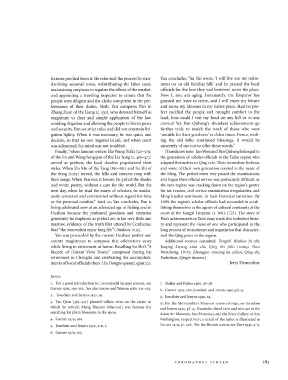Page 299 - Decorative Arts, Part II: Far Eastern Ceramics and Paintings, Persian and Indian Rugs and Carpets
P. 299
fectures profited from it. He reformed the process by stan- Yan concludes, "Su Shi wrote, 'I will live out my retire-
dardizing seasonal levies, redistributing the labor costs, ment on an old familiar hill,' and he praised the local
maintaining surpluses to regulate the effects of the market, officials for the love they had bestowed upon the place.
and appointing a traveling inspector to ensure that the Now I, too, am aging. Fortunately, the Emperor has
people were diligent and the clerks competent in the per- granted me leave to retire, and I will enjoy my leisure
formance of their duties. Sixth, Yan compares Pan to and nurse my illnesses in my native place. Had no pre-
Zhang Zuan of the Liang (c. 530), who devoted himself as fect pacified the people and brought comfort to the
magistrate to clear and simple application of the law, land, how could I rest my head on any hill or in any
avoiding litigation and allowing the people to live in peace crevice? Yet, Pan Qisheng's abundant achievements go
and security. Pan set strict rules and did not entertain liti- further truly to match the work of those who were
gation lightly. When it was necessary, he was quick and 'notable for their goodness' in olden times. Hence, wish-
decisive, so that no one lingered in jail, and when court ing the old folks continued blessings, it would be
was adjourned, his mind was not troubled. unseemly of me not to offer these words."
Finally, "when famous writers like Wang Xizhi (321-379) [Translators note: Yan Wosi and Pan Qisheng belonged to
of the Jin and Wang Sengqian of the Liu Song (c. 465-472) the generation of scholar-officials in the Taihu region who
served as prefects, the local dandies popularized their adapted themselves to Qing rule. Their immediate forbears
styles. When Du Mu of the Tang (850-851) and Su Shi of and some of their own generation resisted in the name of
the Song (1079) served, the hills and streams rang with the Ming. The period when they passed the examinations
their songs. When Pan was at leisure, he pulled the shades and began their official service was particularly difficult, as
and wrote poetry, without a care for the world. But the the new regime was cracking down on the region's gentry
next day, when he read the essays of scholars, he assidu- for tax evasion, civil service examination irregularities, and
ously corrected and commented without regard for time Ming loyalist sentiments in their historical narratives. By
or for personal comfort." And, so, Yan concludes, Pan is 1690, the region's scholar-officials had succeeded in estab-
being celebrated now at an advanced age in Beijing and in lishing themselves as the agents of cultural continuity at the
Huzhou because the profound goodness and immense court of the Kangxi Emperor (r. 1661-1721). The story of
generosity he displayed as prefect are in his very flesh and Pan's achievements in Yan's essay mask this turbulent histo-
marrow, evidence of the truth first uttered by Confucius, ry and represent the views of one who participated in the
that "the benevolent enjoy long life" (Analects, 6:23). long process of recruitment and negotiation that character-
Yan was persuaded by the current Huzhou prefect and ized the Qing peace in the region.
county magistrates to compose this celebratory essay Additional sources consulted: Tongzhi Huzhou fu zhi;
while living in retirement at home. Recalling Su Shi's "A Jiaqing Liyang xian zhi; Qing shi jishi (comp. Guo
Record of Distant View Tower," composed during his Wencheng, 1970); Zhongguo renming da cidian; Qing shi;
retirement in Chengdu and celebrating the accomplish- Fashishan, Qingbi shuwen.]
ments of local officials there (Su Dongpo quanji, qian:32), Jerry Dennerline
NOTES
1. For a good introduction to Coromandel lacquer screens, see 7. Stalker and Parker 1960,36-38.
Garner 1979,259-262. See also Jenyns and Watson 1980, 231-233. 8. Garner 1979, 262; Jourdain and Jenyns 1950, pi. 13.
2. Jourdain and Jenyns 1950,19. 9. Jourdain and Jenyns 1950,19.
3. Tao Qian (365-427) planted willow trees on the estate to 10. For the Metropolitan Museum screen of 1690, see Jourdain
which he retired; Meng Haoran (689-740) was famous for and Jenyns 1950, pi. 14. Examples dated 1670 and 1672 are in the
searching for plum blossoms in the snow. Asian Art Museum, San Francisco, and the Freer Gallery of Art,
4. Garner 1979, 260. Washington, respectively; a detail of the latter is illustrated in
5. Jourdain and Jenyns 1950, 2in. i. Garner 1979, pi. 206. For the Boston screen, see Dart 1945: 4-9.
6. Garner 1979, 259.
C O R O M A N D E L S C R E E N 283

